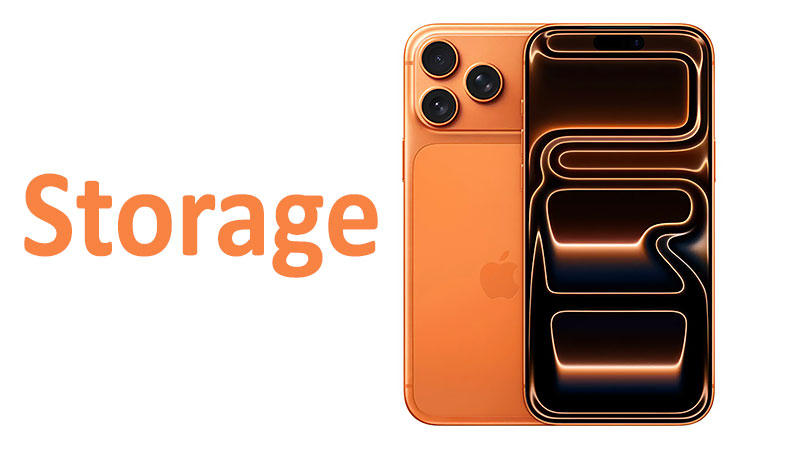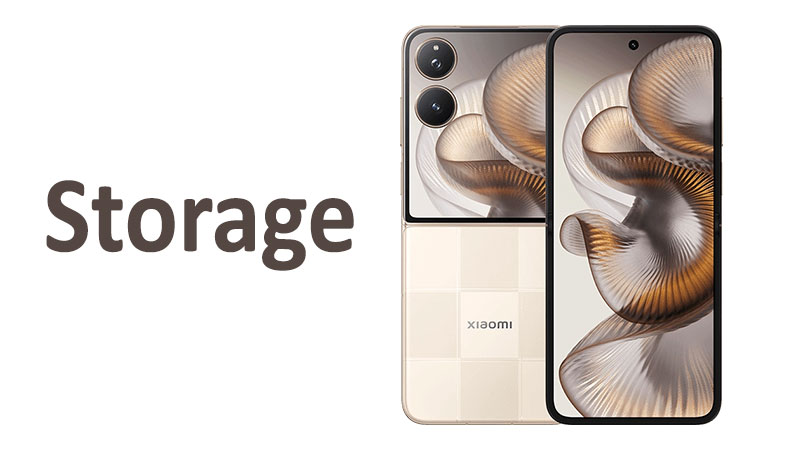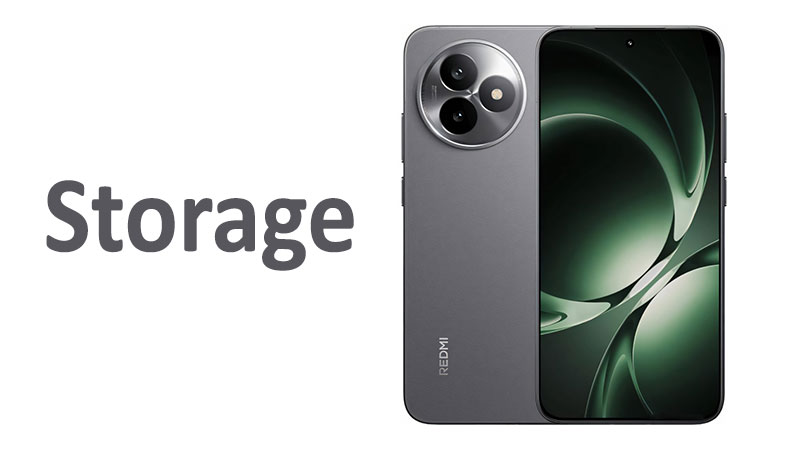The Apple iPhone 17 Pro Max Storage system represents a huge leap forward. Storage capacity and speed are now more critical than ever before. This is especially true for professional users and content creators. We will explore the available capacity tiers. We will also analyze the underlying storage technology. Understanding these elements is essential for making an informed purchasing decision.
The Importance of High-Speed Storage
Modern smartphones perform tasks that were once reserved for desktop computers. They handle complex applications and intensive media creation. High-speed storage is the backbone of this performance. It ensures a smooth user experience.
Slow storage causes frustrating bottlenecks. For example, apps load slowly. Video rendering times increase significantly. High-speed internal memory allows the processor to work at its maximum potential. Therefore, the type of storage technology is equally as important as the quantity.
Storage Options: The New Capacity Tiers
The iPhone 17 Pro Max offers four distinct storage capacity options. Apple removed the lower capacity tiers found in older models. This shift acknowledges the growing demands of mobile data consumption.
The available options are:
- 256GB
- 512GB
- 1TB
- 2TB
The inclusion of the 2TB option is a milestone. It positions the iPhone 17 Pro Max as a genuine replacement for many entry-level laptops. Users now have true freedom to create and store massive files on their mobile device.
The Technology Under the Hood: Storage Type
Apple utilizes a highly customized type of flash memory. This memory is known as NAND flash storage. The iPhone 17 Pro Max likely employs an advanced NVMe-based controller. NVMe stands for Non-Volatile Memory Express. This protocol delivers blazing-fast read and write speeds.
NVMe Architecture and Performance
NVMe allows for parallel data processing. It significantly reduces latency compared to older storage standards. This technical advantage is crucial for high-resolution video workflows. The entire system feels instantly responsive because of this speed.
The iPhone’s internal storage acts like a high-performance solid-state drive (SSD). It is tightly integrated with the A-series chip. This integration provides optimized data paths. Consequently, file transfer speeds are exceptionally quick. App performance gets a tangible boost.
Comparison: Many competing Android phones use UFS (Universal Flash Storage). While UFS is fast, Apple’s proprietary NVMe implementation often yields superior sustained sequential read/write speeds. These sustained speeds are vital when recording high-bitrate video like ProRes. The dedicated hardware controller manages thermal efficiency better. This helps prevent performance throttling during long recording sessions.
Why Storage Speed Matters
Speed affects more than just app installation time. High-resolution video editing is a perfect example. Editing 4K or 8K footage requires constant reading and writing of massive data chunks. Faster storage prevents stuttering during playback. It speeds up final export times dramatically.
Furthermore, computational photography relies on rapid data transfer. The phone captures many images instantly to create one final photo. Quick storage enables this sophisticated background processing. This speed ultimately contributes to better final image quality.
Detailed Analysis of Capacity Tiers
Choosing the correct capacity is the most critical decision a buyer faces. Storage is non-expandable on the iPhone. Therefore, buyers must plan for future needs. Each tier caters to a different type of user.
The 256GB Base Model
The 256GB model is the starting point for the Pro Max line. This capacity is suitable for the mainstream power user. This includes users who primarily rely on cloud services. They might stream most of their music and videos.
This tier works well for capturing standard photos and 4K video occasionally. It is a good choice if you consistently manage your storage. However, intensive creators will quickly find this space restrictive. Using professional ProRes video will fill this capacity very quickly.
Buyer Insight: If you use iCloud Photos and frequently offload your data, 256GB might suffice. If you plan to use Apple Log 2 or ProRes, avoid this entry-level option.
The 512GB Mid-Range Option
The 512GB option represents a healthy balance of capacity and cost. This tier is excellent for enthusiastic photographers and casual videographers. It provides plenty of space for a large music library and many apps.
This capacity handles standard high-quality video recording comfortably. It gives users a buffer for downloading movies and games. The 512GB model is generally the sweet spot for most serious mobile users. It offers freedom without the highest price premium.
Comparison: This capacity is double the storage of many mid-range professional devices. It provides confidence for a full year of intensive use. This is before any necessary data cleanup.
The 1TB Power User Tier
The 1TB option is designed specifically for content creation professionals. This tier is necessary for heavy use of high-bitrate video codecs. This includes ProRes RAW and the new 3D spatial video. These formats generate gigantic files.
For example, one minute of 4K ProRes 422 HQ footage can consume several gigabytes. The 1TB option offers hours of this professional-grade video storage. This capacity is also ideal for mobile game developers and serious graphic designers. These users require huge local files and expansive app libraries.
Buyer Insight: If your workflow involves transferring large video projects directly from the phone, 1TB is a safe minimum. It minimizes the need for continuous data offloading.
The Groundbreaking 2TB Flagship Option
The 2TB tier is the most significant addition to the iPhone 17 Pro Max. This massive capacity is aimed at the absolute professional. It targets users who shoot feature-length projects on their phone. This includes virtual reality creators and documentary filmmakers.
The 2TB option also caters to users who need maximum data redundancy. They can keep years of photo memories and an extensive media library locally. This capacity virtually eliminates all storage anxiety. It ensures the phone is always ready to record, regardless of location or internet access.
Comparison: Providing 2TB of high-speed NVMe storage in a smartphone rivals high-end laptop configurations. This option is currently unique in the mobile market segment. This capacity cements the iPhone’s status as a serious professional tool.
Storage Demands of Pro Features
The advanced camera system drives the need for greater storage. Buyers must understand how specific features consume space. The high capacity options are a direct response to these demands.
ProRes and Apple Log 2 File Sizes
ProRes is a professional video compression format. It offers high visual quality with minimal loss. However, the resulting file sizes are huge. Apple Log 2 maximizes dynamic range. When combined with ProRes, the data requirements skyrocket.
A professional shoot requires terabytes of storage. The 1TB and 2TB options are essential here. Users must factor this into their budget. Investing in high capacity protects your workflow efficiency.
3D Spatial Video Impact
The new 3D spatial video feature records complex data. It captures two simultaneous video streams plus depth data. This combined data stream uses up storage space rapidly. This content is crucial for the new mixed-reality ecosystem.
Recording 3D video demands faster write speeds and large capacity. The NVMe technology handles the speed requirement. The larger storage tiers meet the necessary capacity needs. This feature alone justifies the increased storage tiers.
App and Gaming Requirements
Modern mobile games are highly detailed and graphically intense. They often require several gigabytes per title. Power users may install dozens of large games. Storage is quickly consumed by these entertainment files.
Furthermore, applications are growing larger and more complex. Development environments, large map caches, and media editing apps all demand space. Choosing a smaller capacity forces difficult choices about app management. This compromises the user experience.
Pros and Cons of iPhone 17 Pro Max Storage
Advantages (Pros)
| Feature | Benefit |
|---|---|
| 2TB Maximum Capacity | Offers unmatched storage freedom for professional video and media. |
| Advanced NVMe Technology | Provides ultra-fast read/write speeds, eliminating performance bottlenecks. |
| High Base Capacity (256GB) | The starting point is generous for most general-purpose users. |
| Consistent Speed | Guaranteed high-speed performance across all capacity tiers. |
Disadvantages (Cons)
| Feature | Concern |
|---|---|
| No Expansion Slot | Storage capacity is fixed upon purchase; users cannot add a microSD card. |
| Cost Premium | Upgrading to 1TB or 2TB significantly increases the overall device cost. |
| Overkill for Casual Users | The largest capacities may be unnecessary for users who stream all media. |
| Cloud Dependency | The fixed capacity requires users to rely on iCloud for long-term data archiving. |
Key Considerations for Buyers
Choosing the right storage requires honest assessment of your usage. Consider both your current needs and your future usage patterns.
Future-Proofing Your Purchase
The iPhone 17 Pro Max will likely last for several years. Your data footprint will only increase over time. High-resolution photos, more apps, and longer video captures will accrue. It is always wise to purchase slightly more storage than you need right now.
Future-proofing means avoiding the hassle of constantly deleting files. It ensures your phone remains performant throughout its lifespan. Skimping on storage now often leads to frustration later.
Calculating ProRes Storage Needs
If you plan to use ProRes, estimate your daily or weekly usage. One minute of high-quality 4K ProRes can take 6GB or more. Just one hour of shooting might consume over 360GB. This simple calculation demonstrates the necessity of the 1TB and 2TB options. Professionals should calculate their storage needs carefully before purchasing.
The Cloud Storage Balance
Apple strongly encourages using iCloud for backup and media storage. iCloud can offload full-resolution photos and videos. This frees up local device space. Users who pay for a large iCloud plan can manage with smaller local capacities.
However, relying solely on the cloud has drawbacks. Accessing high-bitrate files requires a fast internet connection. Professionals often need immediate, local access to their data. Therefore, local storage should be prioritized for frequently accessed and mission-critical media.
Price vs. Performance Trade-off
The cost difference between capacity tiers is substantial. However, the performance gained from large, fast storage is invaluable. Consider the cost of professional downtime. If the phone runs out of storage during a critical shoot, the monetary loss can be significant. The extra investment in storage is effectively insurance against lost work.
Conclusion: Making the Right Storage Decision
The Apple iPhone 17 Pro Max Storage system is exceptional in both capacity and speed. The advanced NVMe technology ensures lightning-fast performance. This performance is vital for complex tasks and professional video recording. The introduction of the 2TB option satisfies the highest demands of modern content creation.
For casual users and cloud-focused individuals, the 256GB or 512GB tiers offer excellent value. For serious videographers, filmmakers, or mobile developers, the 1TB or 2TB models are mandatory. Ultimately, the correct choice is the one that prevents you from ever seeing the “Storage Full” warning. Do not compromise on storage capacity. It is the only component you cannot upgrade later. Choose the largest capacity you can reasonably afford.
FAQ
Can I upgrade the storage on my iPhone 17 Pro Max later?
No, the iPhone’s internal NAND storage is permanently soldered to the motherboard. You must select the correct storage capacity when you purchase the device.
Is the storage speed faster on the 2TB model compared to the 256GB model?
No, all capacity tiers (256GB, 512GB, 1TB, 2TB) generally use the same high-speed NVMe flash controller. Therefore, read and write speeds should be consistent across the range.
Does the iPhone 17 Pro Max support external storage devices?
Yes, you can connect external SSDs via the USB-C port. You can record video directly to these drives. However, the phone’s internal storage remains faster for general use.
What is the difference between NVMe and the storage in older iPhones?
NVMe is a communication protocol specifically designed for high-speed flash memory. It allows data to be read and written much faster than the older SATA-based protocols used in earlier generations of mobile storage.
How much space does the operating system (iOS) use?
The operating system, pre-installed apps, and recovery partition typically use between 10GB and 20GB of space. This amount is subtracted from the total advertised capacity on all models.



